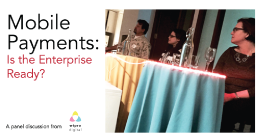Haptic Feedback: Changing the Human-Digital Experience
September 3, 2015
By David Engel, Senior Associate, Research & Consulting

I first learned about haptic technology, or haptics, back in the summer of 2008 when I was interning at a strategic foresight consulting firm. Haptic feedback occurs when you touch something like a phone screen and feel something like a vibration. The firm studied trends, so I was asked to beef up on haptic feedback basics by researching news articles and various publications. Back then, a few companies were already using the technology, but it wasn’t quite “there yet.” For example, when touching a phone screen, the vibration wasn’t localized. Remember when Nintendo Wii debuted back in 2006? The user could swing the controller to play tennis, and the remote would vibrate.
 left: apple.com, right: wccftech.com
left: apple.com, right: wccftech.com
Fast-forward seven years, and haptic feedback is now present in a lot more consumer technology. Apple’s new Watch has a “Taptic Engine,” which can be set up to send many different types of feedback, from a tap to multiple vibrations to a heartbeat. Beyond the haptic feedback, it also has a feature called “Force Touch,” which is when the user presses down at varying degrees of pressure instead of gesturing in different directions. Combining these two technologies, usually with sound, makes the user feel like a physical button is being pressed. Pretty cool, right?
I decided to go to an Apple Store and check out these features – come to find out, they're also available on some of the MacBooks. The user experience changes when engaging with these products. I really felt like I was pushing a button when I was pressing down on the MacBook Pro’s touchpad even though I knew the touchpad wasn’t moving. Hearing the click helped the illusion. The user can adjust the click pressure setting on a scale from light to medium to firm. It was incredible, literally.
 Taptic Engine - MacBook Pro touchpad (wired.com)
Taptic Engine - MacBook Pro touchpad (wired.com)
Before this pairing of haptic feedback and “Force Touch,” what we saw on our screens and what we sensed with our fingers were unrelated. One could move a mouse to the edge of a computer screen, but you wouldn’t feel anything letting you know it's the edge of the screen. With this sublime combination, the interaction with user interfaces has the potential to become radically different, and it’s already begun. As Kyle Vanhemert writes in his Wired Article, “Apple’s Haptic Tech is a Glimpse at the UI of the Future”, Apple added a haptic feedback upgrade with many interactions in iMovie such as when a user drags a video clip to the end, the user will feel feedback telling the user that the video clip has finished. A freelance film editor, Alex Gollner, called this innovation “Bumpy Pixels.” I recreated this scenario in the Apple store, and the bump is very slight, but definitely noticeable.
 Source: Apple
Source: Apple
Think of the possibilities! Imagine feeling the outline of keys on a virtual keypad on an iPhone 6 when tweeting or updating your Facebook status. How about moving images or text boxes around on a PowerPoint slide on your Windows Surface and feeling a bump when the objects line up? Haptic feedback could also help designers using Wacom tablets by creating a “barrier” around objects to stay within as well as a “barrier” to stay within the tablet itself. These features are almost here, and they will help us work more efficiently and effectively by engaging and combining our visual and touch senses.
 Source: brandsandinnovation.com
Source: brandsandinnovation.comWilder still, an Apple patent was just published a few months ago titled “Touch Surface for Simulating Materials.” The patent describes the ability of a device to change temperature in order to create the illusion of touching different materials such as a wooden surface. Now, envision scrolling through your Facebook newsfeed and being able to feel the fabric of a dress in a J Crew ad or the softness of a West Elm rug. These types of interactions are still in the future, if possible at all; however, there are endless opportunities to create a richer user experience for consumers.
How do you think haptic feedback will change our interaction and experience with technology? We’d love to hear your thoughts below.
Designs By Lisa Vissichelli, Digital Designer & Adel Brihmat, Digital Design Assistant
Edited By Gina Gioldassis, Operations & Communications Coordinator
Social Media by Janine Walsh, Operations & Community Manager














